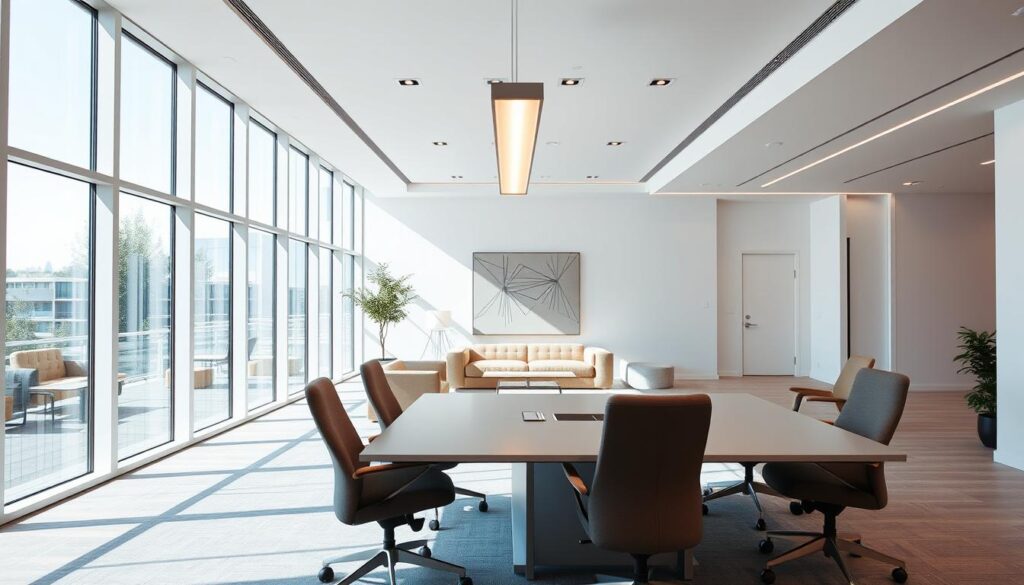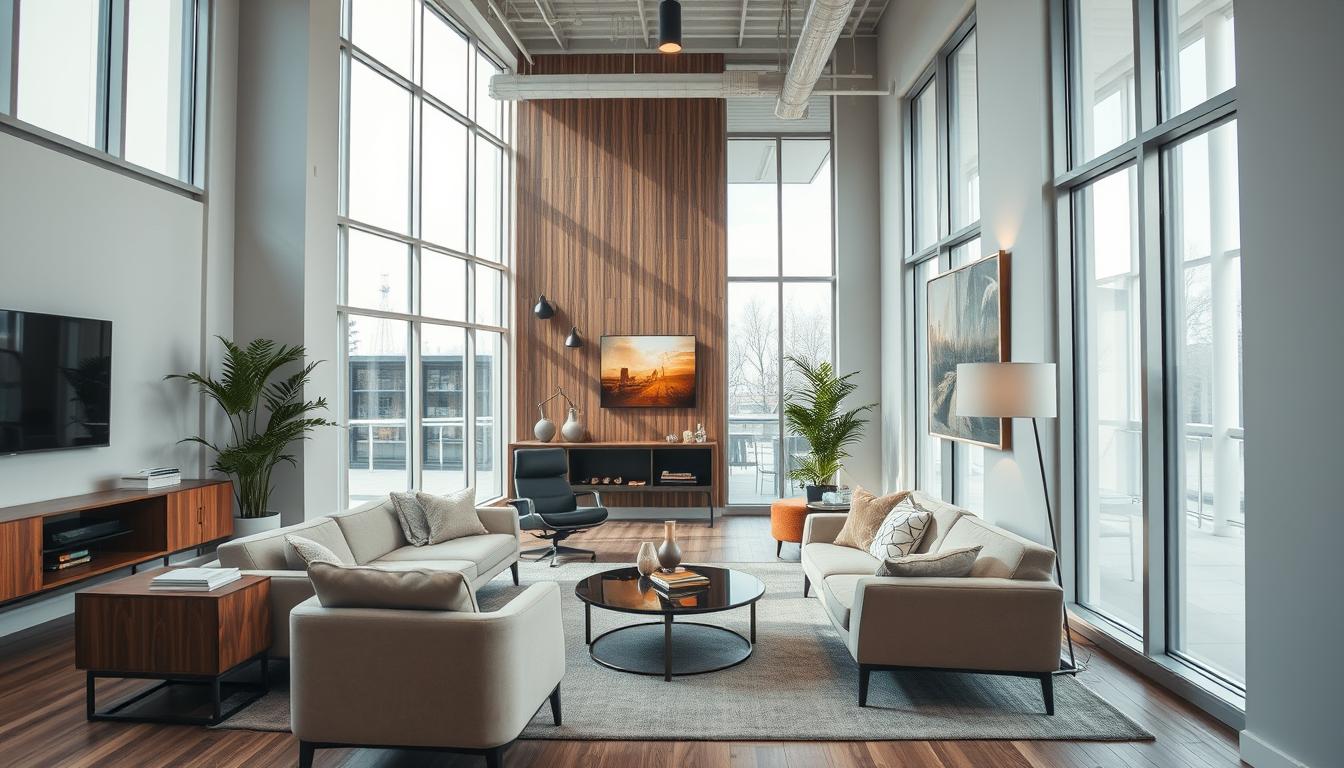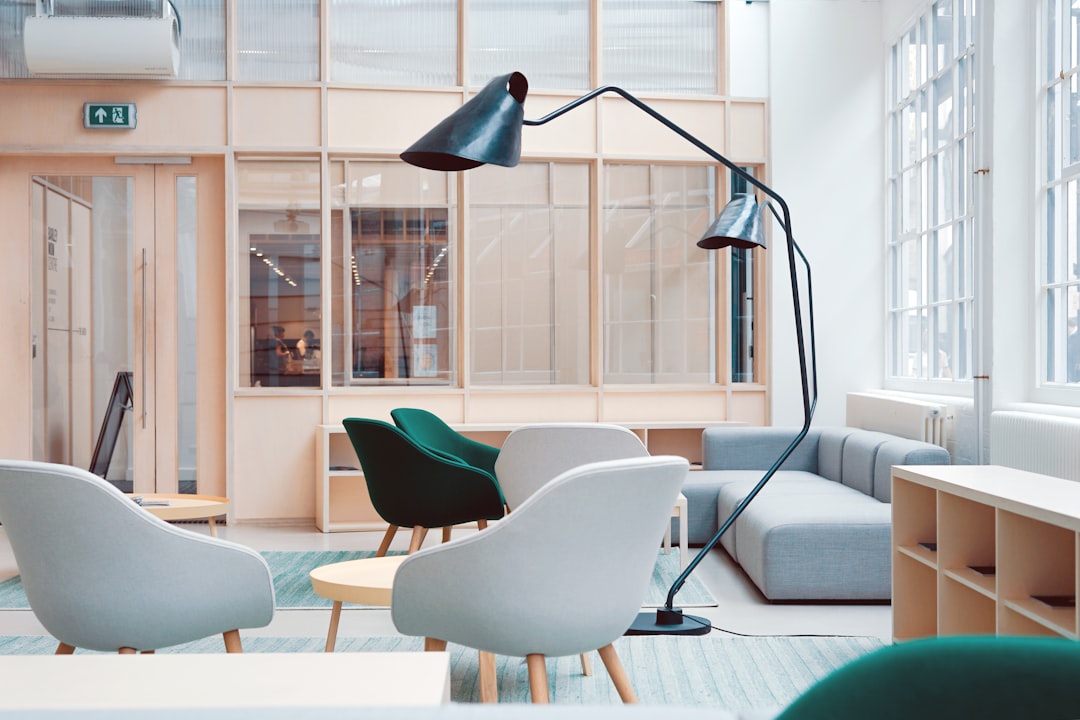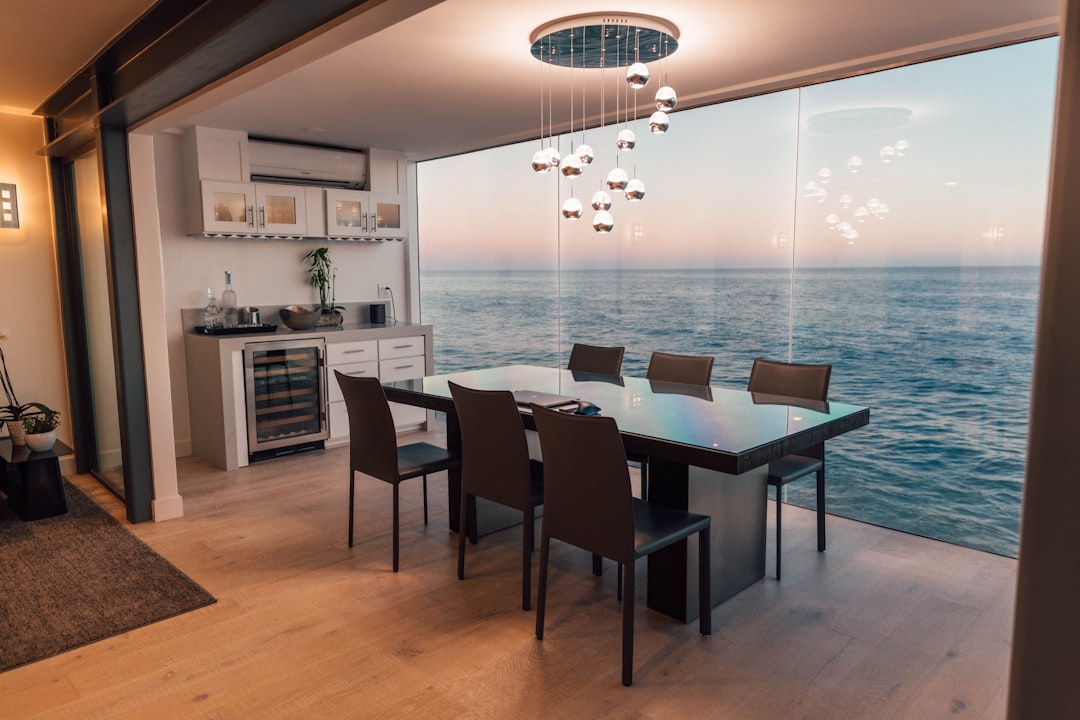Did you know a well-designed space can make you 20% more productive? This shows how crucial interior design services are. They make places both beautiful and useful.
We’ll see how interior designers change homes and offices. They plan and design spaces to make them healthier. They listen to what clients want, pick colors, and choose materials and furniture. This ensures the space looks great and works well.
Key Takeaways
- Interior designers create spaces that are both beautiful and functional.
- Their work involves understanding client needs and preferences.
- They select color schemes, materials, and furnishings to achieve the desired design.
- A well-designed space can have a significant impact on productivity and well-being.
- Interior design services are essential for transforming living and working environments.
Overview of Interior Design
Interior design mixes art, science, and creativity to make spaces both beautiful and useful. It has grown a lot, thanks to new tech, cultural changes, and different lifestyles.
When we dive into interior design, knowing its basics is key. Interior decorating is a big part of it. It’s about picking out furniture, colors, and finishes that show off the person’s style and make a space work better.
Definition of Interior Design
Interior design is about understanding people to make spaces that are both pretty and practical. It’s all about lighting, color, texture, and furniture. The goal is to make a space that looks good and works well for everyone.
In residential interior design, it’s about making homes that are not just pretty but also cozy and safe. It takes a lot of attention to detail and knowing how to mix looks with function.
Importance of Interior Design
Interior design is very important. Good design can make you more productive, happier, and even improve your life quality. In homes, a well-designed space can be a peaceful retreat, making life easier and more enjoyable.
But interior design is more than just looks. It’s also about making spaces that are useful and easy to use. This is true for interior decorating, where the right furniture and decor can really change how a space works.
By learning about interior design and using what you know, you can make your living and work areas both beautiful and practical.
Key Responsibilities of Interior Designers
Interior designers do a lot of work. They plan spaces and pick out furniture. They make sure the space looks good and works well for everyone who uses it.
Space Planning and Layout
Planning the space is very important. Designers figure out how to use the space best. They measure it, think about what the client needs, and make a plan.
A good plan makes a room better. It helps people move around easily and makes the space more comfortable.
Choosing Color Schemes
Picking colors is a big job. Colors change how a room feels. Designers think about how colors affect us and what the client likes.
For example, soft colors are great for bedrooms. Bright colors are better for places where you want to be creative.
Selecting Materials and Furnishings
Choosing materials and furniture is key. Designers pick things that look good and last long. They find furniture that is comfy and works well.
They also pick out things like lights and fabrics. The goal is to make a space that looks good and feels right.
| Material | Durability | Aesthetic Appeal |
|---|---|---|
| Hardwood | High | Classic, Timeless |
| Laminate | Medium | Versatile, Cost-effective |
| Marble | Low | Luxurious, Elegant |
Interior designers make spaces that are both pretty and useful. They work on homes, offices, and hotels. Their job is to make the client’s dream come true, while making sure it’s practical and looks great.
The Interior Design Process
Our interior design services start with a detailed process. This includes talking to clients, creating a design plan, and bringing it to life. We focus on what our clients need and want, whether it’s for a home or a commercial space.
Designing interiors is complex. It needs creativity, technical skills, and good project management. We aim to make spaces that are both useful and beautiful, fitting the client’s lifestyle or business.
Initial Consultation
The first step is the initial consultation. Here, we talk about what the client wants, their budget, and preferences. It’s key to understand the project’s goals and what’s needed.
We also check out the space. We look at its size, lighting, and architecture. This helps us start planning and spotting any challenges or chances.
Concept Development
Next, we work on the design concept. We aim to match the client’s vision and goals. We pick colors, materials, and furniture that fit the design and purpose of the space.
We show the client our design idea. We use things like 3D models or mood boards to show what we plan. We listen to feedback and work together to make sure it’s just right.
Implementation
The last step is bringing the design to life. We buy the materials and furniture, and work with contractors to make it happen.
We keep in touch with the client during this time. We make sure everything goes smoothly and fix any problems quickly. The end result is a space that looks great and works well for the client.
Our structured process helps us provide top-notch interior design services. We meet the specific needs of each client, whether it’s for a home or a commercial space.
Collaboration with Clients
Working closely with clients is key to a successful interior design project. We listen to their needs and preferences. This ensures the design is both beautiful and functional.
Understanding Client Needs
To succeed, we must understand the client’s lifestyle and goals. We do this through detailed consultations. We listen to their ideas and observe their current space.
This helps us create a design that reflects their personality. We also consider their budget and timeline. This way, we can offer a solution that fits their needs and budget.
Presenting Design Proposals
After understanding the client’s needs, we create a detailed design proposal. It includes a description of the design, recommended materials, and a timeline. We use visual aids like 3D renderings to help clients see the final result.
We want clients to feel informed and comfortable with the design. We welcome feedback and make changes as needed. Our goal is to bring the client’s vision to life, creating a space that is both functional and beautiful.
Through teamwork and clear communication, we exceed our clients’ expectations. We create spaces that improve their quality of life and reflect their personal style.
Working with Other Professionals
Effective interior design needs teamwork with many experts. As interior designers, we team up with various professionals. This ensures our clients get what they want and need.
We work closely with architects and builders. Architects shape the building’s structure and layout. Builders make the plans real. We make sure our designs fit the project’s vision.
Architects and Builders
We aim for a smooth mix of design and structure. This means constant talks and planning. We ensure our designs match the building’s architecture.
Contractors and Suppliers
We also team up with contractors and suppliers. Contractors do the construction work. Suppliers give us the materials and products. We check that everything is up to our standards and on schedule.
Landscape Designers
We work with landscape designers too. They create outdoor spaces that match our interior designs. We work together to make sure these spaces are both beautiful and functional.
By teaming up, we create spaces that meet our clients’ needs. This teamwork is key to success in residential interior design and space planning.
Designing for Different Spaces
Designing for different spaces is a complex task. It needs a deep understanding of each environment’s unique needs. As interior designers, we tackle various projects, from homes to offices and hotels. Each project comes with its own set of challenges and opportunities.

Residential Design
Residential design aims to create living spaces that are both useful and beautiful. It involves understanding homeowners’ needs and tastes. This way, we design homes that show their lifestyle and personality.
Key aspects include space planning, material and furniture selection, and color schemes. For example, a well-designed kitchen is the heart of a home. It’s not just for cooking but also for family gatherings.
Commercial Design
Commercial interior design focuses on creating spaces that are functional, safe, and boost productivity. This design is vital for businesses. It affects employee morale, customer experience, and profits.
In commercial design, we consider brand identity, workflow, and customer flow. For instance, a retail store’s layout can greatly affect customer navigation and buying decisions.
| Design Element | Residential | Commercial |
|---|---|---|
| Space Planning | Focused on comfort and personal space | Focused on functionality and workflow |
| Color Scheme | Chosen for ambiance and personal taste | Selected for brand identity and customer psychology |
| Materials and Furnishings | Emphasizes comfort and durability | Prioritizes durability and ease of maintenance |
Hospitality Design
Hospitality design, including hotels, restaurants, and bars, aims to create inviting and memorable experiences. It requires understanding the brand’s identity and the target audience’s preferences.
“The design of a hospitality space can make or break the guest experience. It’s about creating an atmosphere that is welcoming, comfortable, and memorable.”
Effective hospitality design balances beauty with functionality. It ensures spaces are not only stunning but also efficient. For example, a hotel lobby should welcome guests warmly while also being functional for check-in and concierge services.
By grasping the unique demands of residential, commercial, and hospitality design, we offer interior design services tailored to each project. This enhances both the user experience and the client’s brand.
Staying Current with Trends
As interior designers, we know how key it is to keep up with new trends and tech. The world of interior design is always changing. New styles, materials, and ways of doing things pop up all the time. To do our best work, we must know what’s new and use it in our designs.
Design Trends and Style Evolution
Design trends shape the interior decorating world. They range from bold colors to new materials. Right now, there’s a big push for sustainable and eco-friendly design to help the planet. We aim to keep up with these trends and use them in our work. This way, our clients get the latest and most stylish designs.
Keeping up with design styles is also crucial. For example, mid-century modern design is back in style. It focuses on clean lines, less decoration, and being practical. Knowing these trends helps us make spaces that are both stylish and useful.
Sustainable Design Practices
Sustainable design is getting more important in interior design. As people care more about the environment, we’re moving towards eco-friendly materials, energy-saving systems, and ways to reduce waste. We want to make spaces that are not just pretty but also good for the planet. This means thinking about where materials come from, how much energy they use, and their environmental impact.
By using sustainable practices, we can make beautiful spaces that are also good for the planet. This might mean using local materials, designing to save energy, or adding recycled materials to our designs. As designers, it’s our duty to learn about and use these practices in our work.
Certification and Education in Interior Design
Interior design is a field that requires both education and professional certifications. To start a career, designers must complete educational programs and pass certification tests.
Required Qualifications
To become an interior designer, you usually need a degree in interior design or a related field. Colleges and universities offer programs that teach important skills like space planning, furniture selection, and home styling. These programs help designers understand the basics of interior design.
Certifications and Licenses
Professional certifications, like the NCIDQ (National Council for Interior Design Qualification), are highly valued. This certification shows that a designer has met certain standards and keeps up with the latest in home styling and design.
| Certification | Description | Benefits |
|---|---|---|
| NCIDQ | National Council for Interior Design Qualification certification | Enhances professional credibility, demonstrates expertise in interior design |
| LEED AP | Leadership in Energy and Environmental Design Accredited Professional | Specializes in sustainable design practices, improves environmental sustainability |
As noted by the American Society of Interior Designers (ASID), “Continuing education is crucial for interior designers to stay current with the latest design trends, technologies, and sustainability practices.”
The Impact of Interior Design on Well-being
Interior designers are key in making spaces better for our well-being. They help us see the importance of their work in home design. Good interior design makes our homes look great and work well.
Comfort and Functionality
They focus on lighting, color, texture, and furniture to achieve this. For example, natural light and smart lighting can lift our mood and help us work better. Learn more about their work at Cozy Nest Plans.
Mood and Ambiance
Choosing the right colors, textures, and furniture sets the mood of a space. This makes it feel cozy and inviting. Interior designers pick these elements carefully to improve our well-being and daily life.



